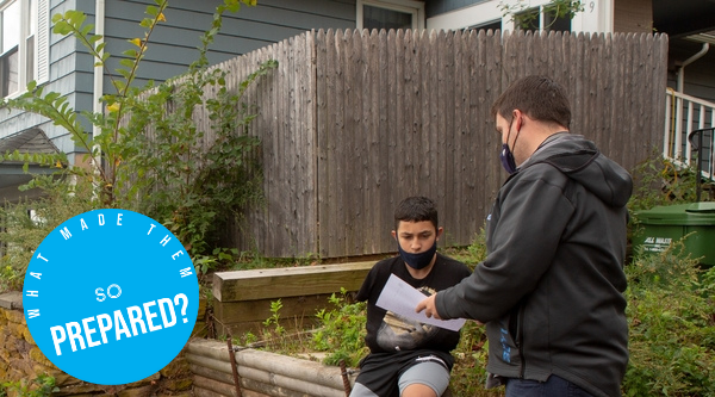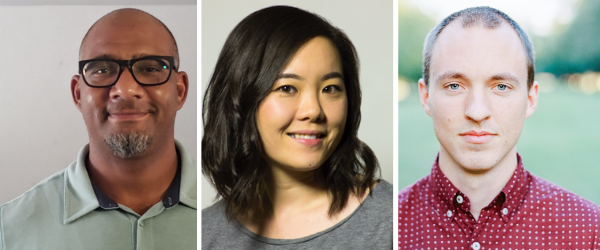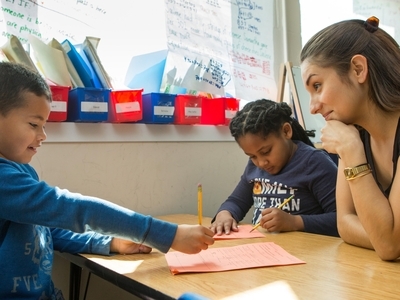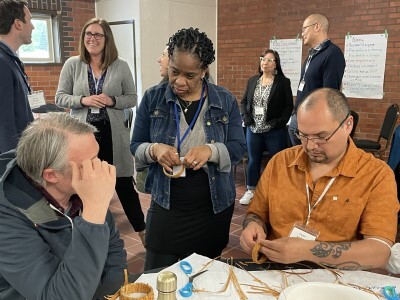Three Schools that Found the COVID-19 Pandemic to Be “Business as Usual”
Topics

Next generation learning is all about everyone in the system—from students through teachers to policymakers—taking charge of their own learning, development, and work. That doesn’t happen by forcing change through mandates and compliance. It happens by creating the environment and the equity of opportunity for everyone in the system to do their best possible work.
What Made Them So Prepared?
A Project about K-12 Resilience
During the pandemic, three learner-centered environments doubled down on what they were already up to: providing learner-centered experiences focused on relationships and the conditions for each child to thrive.
The beginning of the COVID-19 pandemic feels like a world away from where we find ourselves standing today. With each passing moment, we’ve been presented with challenge after challenge after challenge to ensure each of our learners (and their families) is receiving the support and opportunities they need to live into their full potential.
With each challenge, we were given an unsolicited assessment on the strength of our systems and structures. Did meaningful relationships exist between young people, families, educators, and the broader community? Was adaptability built into the operational foundation of our learning models? Did we honor and support the unique backgrounds and circumstances of each family we serve, providing an equitable learning experience for everyone?
Each of these questions was put under the spotlight once “school” as a mandated place children have to physically attend was removed from the equation and all that remained was the culture and community we had built within and around that structure.
Nationally, the results seemed bleak. When the veil of mandated schooling lifted, families and educators began opting out. And, if opting out wasn’t an option, more families were ready for bold change than ever before. The reasons weren’t complicated or nuanced. For young people, they found themselves waking up with a choice: log-in or don’t (that is if they had access to the necessary technology in the first place). For parents and guardians, they had a front row seat to the learning experiences of their children and could make a clear determination as to whether or not this was the type of learning experience they wanted for them. And, for educators, weighing the confidence and trust they had in (and from) leadership as well as their personal financial security, they were ready to lean in, bow out, or do just enough to keep them employed.
“Everyone has been so open-minded about what learning looks like during this moment. It’s made everyone feel like this isn’t all that bad. It’s business as usual. It’s learning.”
–Johnna Noll, Norris School District
What we want to explore are the learning communities where “leaning in” was the clear and easy choice. And, what made it so.
Learner-Centered Education in Action
At Education Reimagined, we had the opportunity to speak with leaders from three learner-centered environments who saw their learning communities powerfully adapt to the shifting circumstances the COVID-19 pandemic brought (and continues to bring). From rural California and Wisconsin to urban Minnesota, each example showcases what becomes possible when you lead with a learner-centered mindset—a mindset that is built around a set of fundamental assumptions (as laid out in Education Reimagined’s Practitioner’s Lexicon) about young learners themselves, where:
- Each learner is related to as unique in meaningful ways—there are no “typical” or “average” learners. They have unique backgrounds and circumstances, individual strengths and challenges, and their own interests and aspirations;
- Each learner is seen as having inexhaustible potential—potential that will unfold in different ways for different learners;
- Each learner has an innate desire to learn and grow. Every single learner can be supported in being extraordinary in their own way; and
- Each learner co-creates their educational goals and pathways for reaching those goals.
These three learning environments hold these assumptions about young people at the core of their work within their vision for learner-centered transformation. We have found that, as a result, these three learning environments already had the foundation in place to successfully navigate the challenges presented by the COVID-19 pandemic. Each story—and the structures and supports they had in place—are unique to their respective communities.
By seeing every child as curious, wondrous, capable, and unique, each environment saw learner engagement and attendance remain steady, family involvement increase, and educators operate on a daily basis with confidence and resolve.
Norris School District (Mukwonago, Wisconsin)
Norris School District is a small public district in Mukwonago, Wisconsin, that has two learning environments—Norris Academy and Norris Virtual Academy. The first task for any learner who enrolls at Norris School District is to discover themselves. By focusing on four interwoven diagnostic assessments, learners explore their unique identities through the lenses of academics, citizenship, employability, and wellness (physical and mental). These assessments form the foundation for tracking future personal growth as the learner develops their knowledge, skills, and dispositions toward learning.
This focus on self-awareness and self-knowing is a natural outcome of a broader vision for learning that values intentional and consistent reinvention (at a pace of every three to six months), individually and organizationally. Johnna Noll, Norris School District’s executive director, noted, “Our team is always asking ourselves: What do we need to get closer to our vision? What challenge is preventing us from achieving our vision? The pandemic played into that adaptability. We just needed to ground everything in our why.”
This clear and unifying “why” was Norris’s greatest asset when the pandemic began shifting life as we knew it. When Wisconsin’s governor announced every district throughout the state had three days to move from in-person learning to virtual learning, Norris made the transition in a single day. Plans were already in the works at Norris before the announcement thanks to their focus on serving the unique needs of every child and family. “Even if schools weren’t ordered to be closed, we wanted to make sure we could serve any student and family who felt uncomfortable being in a crowded space… our entire team was ready to travel to different sites or do [home visits] to help think through challenges,” said Noll.
In their pre-planning, they had two major priorities: 1) keep relationships strong, and 2) ensure every learner has the appropriate technology at their disposal. On day one of virtual learning, only one learner had poor internet access, which was handled through quick coordination with the local internet provider. Reflecting on the transition, Noll shared, “Everyone—from our staff to our learners to our parents—has been so open-minded about what learning looks like during this moment. It’s made everyone feel like this isn’t all that bad. It’s business as usual. It’s learning.”
Not only did learning continue at Norris, it expanded. Thanks to their doubling down on cultivating strong relationships with each young learner, they were actually able to increase the number of foundational learning pathways they could offer and created new adult roles to support learners. They also increased enrollment from 115 learners to a projected 150 learners (this includes learners within the district’s boundaries and across the state of Wisconsin).
This and other positive developments made Noll genuinely wonder, “What added value does the building provide, and whatever that value is, how can it be created without it?”
Norris’ commitment to “an educational model where all learners are leaders, exercising voice in creating relevant, powerful learning experiences” doesn’t contain Norris to a brick-and-mortar model of schooling. And, the COVID-19 pandemic has opened up new thinking about the role such a building plays (or doesn’t) in the growth and development of the young people Norris serves.
The pandemic didn’t cause Norris to slow down or look to a return to in-person as the only means of serving learners well again. Rather, they continued marching on and improving their learning model every day, increasing enrollment, fostering learner and family engagement, and creating new adult roles for learners along the way.
When asked for a main insight to share during the pandemic, Noll said, “Don’t replicate what someone else is or has. Get inspired. But, know the needs of your learners, staff, and community. Make sure you create the systems that can be flexible and adaptable to meet the needs of your unique learners.”
Key Takeaways
Structures and practices that enabled Norris School District to serve learners and families well before and during the pandemic:
|
“Our population of kids is dealing with trauma, unstable housing, mental health challenges, substance abuse, and other barriers to learning. That didn’t change during the pandemic.”
–Joey Cienian, High School for Recording Arts
High School for Recording Arts (St. Paul, Minnesota)
High School for Recording Arts (HSRA) is a public charter school in St. Paul, Minnesota, serving learners who are often pushed out by the conventional education system. HSRA’s learner-centered model empowers every learner to find value in their life story and connect that value to the unique impact they want to make within their community and beyond. When that connection is clear, learners launch themselves into open-walled opportunities that connect their passion for music and other emerging interests with community needs.
HSRA’s executive director, Tony Simmons, said one of the core elements of how HSRA operates is to “elevate that we see [our learners’] brilliance, wisdom, and resilience.” It is through this acknowledgement that they are able to cultivate a learning environment where learners “see HSRA as a refuge for connection and support.”
While observing and documenting HSRA’s work during the COVID-19 pandemic, Michael Lipset (HSRA’s director of social impact) and Dr. Linda Nathan (the executive director of the Center for Artistry and Scholarship) noted, “By focusing on relationships, HSRA places human needs before academic achievement, understanding that one leads to the other.” Joey Cienian, HSRA’s director of educational programming, remarked, “We didn’t pivot 180 degrees in the pandemic. We adapted, expanded, and looked at our practices to adjust virtually. We didn’t need to reinvent the wheel.”
One of these unique design components that made HSRA’s transitions so smooth is their staffing structures: 55 of HSRA’s 70 staff members are non-traditional educators. Each young learner has an advisor and a “Care 4 Team” that includes a social worker, personal advisor/student support specialist, content advisor/licensed teacher, and special education teacher. This diverse and strong network of support within the learning environment itself ensured that when lockdowns began, each learner had multiple points of contact and a team of support dedicated to different needs no matter their circumstance. Content advisors, for example, focused on a learner’s learning experiences and goals; personal advisors and social workers focused on a learner’s learning and ensured necessary access to resources for housing, counseling, healthcare, daycare, and employment. For example, they might conduct home visits or identify the location of learners who are without or have unstable housing.
Cienian noted, “Our population of kids is dealing with trauma, unstable housing, mental health challenges, substance abuse, and other barriers to learning. That didn’t change during the pandemic.” So, their pre-pandemic staffing structure, one that prioritized meeting the needs of each individual learner by diversifying the roles of those supporting them, was more important than ever once the pandemic began.
And, although each “Care 4 Team” is made up of people playing varied unique roles, every staff member at HSRA sees themselves as sharing the same responsibility—to ensure every learner is fully supported. This mentality made it easy during the pandemic to deal with unanticipated challenges because there wasn’t a single staff member who said or thought, “This isn’t my job.” When young learners who thrived at HSRA, partly in thanks to the hands-on learning opportunities available to them, refused to engage in online learning, the staff “wrote grants for at-home deeper learning kits based on their interests (to get them such things as cameras, studios at home, dissection kits, VR kits, sneaker design kits),” Cienian said.
Rather than enforcing a compliance-based approach, Simmons noted that “HSRA would not exist if we didn’t buck up and challenge things that didn't make sense...You need to pick your fights and do this in ways that are strategic. If that’s not in you but you’re talking about equity, you aren’t doing equity. You’re doing compliance.”
Key Takeaways
Structures and practices that enabled High School for Recording Arts to serve learners and families well before and during the pandemic:
|
“There was no sense of ‘what’s our minimum obligation?’ Instead, everyone was asking, ‘What do families need and how can we help?’”
–Cinnamon Scheufele, Lindsay USD
Washington Learning Community, Lindsay Unified School District (Lindsay, California)
Washington Learning Community is an elementary environment within Lindsay Unified School District (USD) in Lindsay, California. Lindsay USD has a well-documented story about their community Wi-Fi project and “1 to World” technology initiative that aims to offer every Lindsay learner and family access to free internet and personal technology devices. When the pandemic forced schooling to happen from home, “Some learners felt like, ‘What’s the big deal? Let’s just move it along. Why are we having to wait even a day? I’m ready to go,’” noted Cinnamon Scheufele, Washington’s former principal (up until July 2021) and now Lindsay USD’s executive director of curriculum and instruction. “That is the beauty of our system. Because we’ve been on our transformational journey since 2007, many of the things other districts are battling with during the pandemic aren’t the things we struggled with.”
Operating within a rural agricultural community, Scheufele also noted, “For some learners, their families went into a tailspin—losing their jobs and experiencing significant financial and food insecurity. So, when the pandemic hit, we had a choice: We could focus on ‘teaching’ or we could focus on supporting families. We knew we had to be there for families first.”
By prioritizing family support, Washington Learning Community relied on its family center that provides access to counseling and “homeless youth services,” as well as free breakfast, lunch, and “super snacks.” For families that were unable to access this facility easily themselves, Washington staff made every effort to make it available in other ways, including conducting home visits. Scheufele described the staff’s mindset as, “There was no sense of ‘what’s our minimum obligation?’ Instead, everyone was asking, ‘What do [families] need and how can we help?’ When speaking with families, I would say, ‘I may not be able to solve your problem, but together we can find a way forward.’”
This shared mindset is a result of the strategic shift Lindsay USD made in 2007 when their future plans and principles as a district were designed with community members, learning facilitators, young learners, and parents all at the table. Since the new strategic plan was put into action, Lindsay’s superintendent Tom Rooney always says, “Don’t think about all the reasons why it won’t work. Think of how it could work and go from there.”
Key Takeaways
Structures and practices that enabled Washington Learning Community to serve learners and families well before and during the pandemic:
|
What Made Them So Prepared?
When the pandemic hit, the question Norris School District, High School for Recording Arts, Washington Learning Community, and every school and district in the United States had to answer was: Where do we go from here? For the three learning environments highlighted above, the answer was rather straightforward. They doubled down on what they were already up to: providing learner-centered experiences that focused on relationships and creating the conditions for each unique child's learning to thrive.
They asked, rather than assumed, what type of support each learner and family needed. They remained steadfast to the broader learner-centered visions they had established years or decades prior. And, they provided space for everyone in their learning communities to simply not feel okay during such distressing times. Ultimately, what made these learning environments so prepared for the COVID-19 pandemic was a way of viewing education and learning that centered the human beings benefitting from their services.
By seeing every child as curious, wondrous, capable, and unique, each environment saw learner engagement and attendance remain steady, family involvement increase, and educators operate on a daily basis with confidence and resolve.
Key Takeaways
Structures and practices that enabled learner-centered environments to serve learners and families well before and during the pandemic:
|
This article was developed through the What Made Them So Prepared? project. What can we learn from public schools and districts whose learning models and organizational cultures made them genuinely prepared for the challenges of COVID? The answer should shape public education for decades to come. Nine organizations, assembled into a partnership by Next Generation Learning Challenges (NGLC), are collaborating this year to explore that answer, through a project funded by the Leon Lowenstein Foundation: What Made Them So Prepared? Follow #PreparedProject on Twitter.
Photo at top by Allison Shelley for EDUimages, CC BY-NC 4.0.




